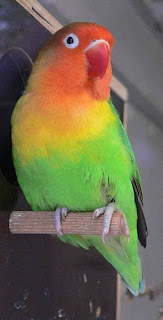 |
| Peach Faced Lovebird |
Class : Aves
Order : Psittaciformes
Family : Psittacidae
Genus : Agapornis
Length : 5-7in (12.5-18cm)
IUCN Status : The Black-Cheeked Lovebird is listed as Vulnerable. Lillian's and Fischer's Lovebirds are Near Threatened. All other species are of Least Concern.
Happy Valentines Day! What better animal to talk about then one that has the word love right there in its name? There are nine different species of Lovebird, all of whom are found natively in Africa, though they are now very popular in captivity. There are now also several feral populations in the United States.
 |
| Fischer's Lovebird |
Lovebirds get their name from the incredibly strong bond that monogamous mated pairs make. They show fierce loyalty and affection toward their mates, are are best kept in pairs. Captive Lovebirds can be kept alone, but they will consider their human owner to be their mate and will need a great deal of attention in order to stay happy and well socialized.
Lovebird commonly live 10-12 years, though there are those who have lived over 20. Most species of Lovebird are in a good condition in the wild, but others, like the Black-Cheeked Lovebird, are listed as vulnerable due to habitat loss.
Comments
Post a Comment